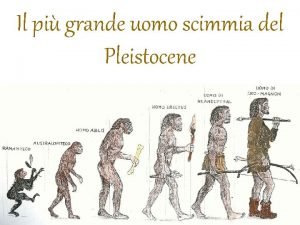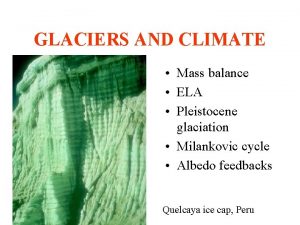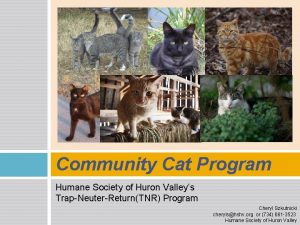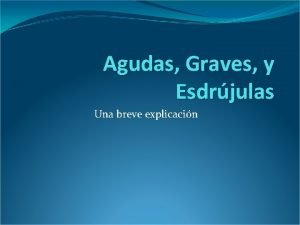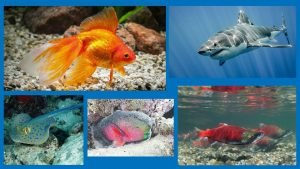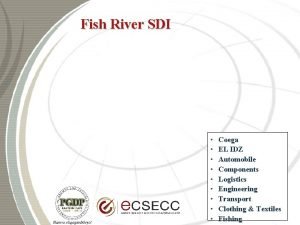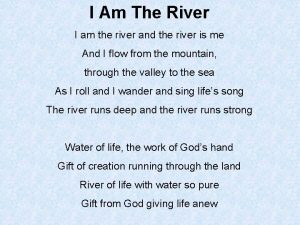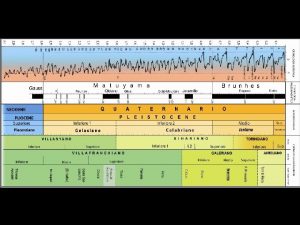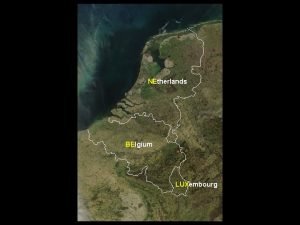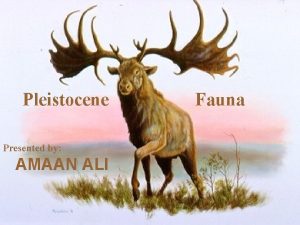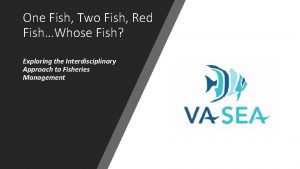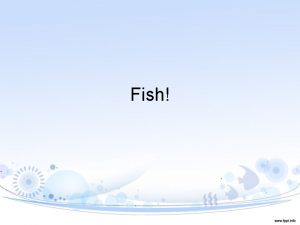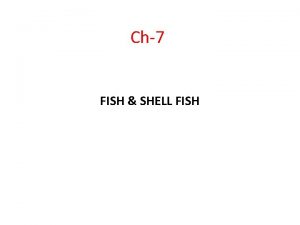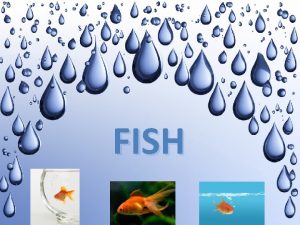The Huron River Fish Community 1 The Pleistocene



























- Slides: 27

The Huron River Fish Community 1

The Pleistocene Epoch • Most recent ice age to date • Forced native species south in refugia • Completely reshaped the topography of Michigan • Opened up new niches for colonizers to occupy

The Huron River Watershed • Comprises an area of approximately 1000 mi. 2 – Main branch: 136 miles – Main branch + tributaries: 367 miles – Headwaters at Big Lake near Huron Swamp in Oakland county – Flows out into northwest corner of Lake Eerie


Early Human Colonization • European settlers arrived in the 1600’s. • Utilized for trade and transportation • Development of the surrounding area increased over time – Draining swamps – Channelization – Lake-level control structures – Hydroelectric Dams


Physiology of temperate, freshwater, lotic fishes • Thermoregulation • Osmoregulation • Morphology

Thermoregulation • Ectothermal (“ecto” = external; “thermal” = heat) – Refers to the source of heat • not variability in body temperature (i. e. homeotherm/poikilotherm), which are outdated terms – Most fishes are ectotherms Source: http: //esi. stanford. edu/temperature 3. htm • Exceptions: Tunas (large bodied fishes)

Thermoregulation • Fish Responses to Temperature : – Behavioral • Dormancy • Swimming rates • Feeding behaviors – Physiological • Metabolism • Enzymatic structure/activity • Gene expression – Morphological • Size changes

Osmoregualtion • Freshwater is more dilute than body fluids • FW fishes maintain water balance by excreting dilute urine.

Morphology • Increased swimming velocity to overcome strong currents – Streamline body, symmetrical caudal fin, derived locomotion • Most adaptations to lotic environments are behavioral Source: Long Term Ecological Research Network, http: //www. lternet. edu/research/keyfindings/river-continuum

Life History • Freshwater is most diverse group of fishes due to diversity of habitats • High seasonality means that fish must cope with differing environments throughout the year • Different environments will favor different suites of traits

Types of Strategies • Opportunistic: small body size, early maturation, low juvenile survivorship • Habitat: areas with high disturbance rates 13

Types of Strategies • Equilibrium: small to medium body size, moderate age at maturation, low fecundity per reproductive cycle, high juvenile survivorship (usually due to parental care) • Habitat: low environmental disturbance rates 14

Types of Strategies • Periodic: large body size, late maturation, high fecundity, low juvenile survivorship • Habitat: highly seasonal but otherwise stable • Example: 15

Community Structure • • • • • • • • Northern brook lamprey Ichthyomyzon fossor (rare) Silver lamprey Ichthyomyzon unicuspis (rare) American brook lamprey Lampetra appendix Sea lamprey Petromyzon marinus Spotted gar Lepisosteus oculatus (rare) Longnose gar Lepisosteus osseus Bowfin Amia calva Mooneye Hiodon tergisus (endangered) Alewife Alosa pseudoharengus Gizzard shad Dorosoma cepedianum Central stoneroller Campostoma anomalum Goldfish Carassius auratus Redside dace Clinostomus elongatus (threatened) Spotfin shiner Cyprinella spilotera Common carp Cyprinus carpio Striped shiner Luxilus chrysocephalus Common shiner Luxilus cornatus Redfin shiner Lythrurus umbratilis (rare) Silver chub Macrhybopsis storeriana (rare) Hornyhead chub Nocomis bigutatus River chub Nocomis micropogon Golden shiner Notemigonus crysoleucas Pugnose shiner Notropis anogenus (rare) Emerald shiner Notropis atherinoides Silverjaw minnow Notropis buccatus (rare) Bigmouth shiner Notropis dorsalis (rare) Blacknose shiner Notropis heterolepis Blackchin shiner Notropis heterodon Spottail shiner Notropis hudsonius Silver shiner Notropis photogenis (threatened) Rosyface shiner Notropis rubellus Sand shiner Notropis stramineus • • • • • • • • Mimic shiner Notropis volucellus • • Pugnose minnow Opsopoeodus emiliae (rare) • Northern redbelly dace Phoxinus eos (rare) Southern redbelly dace Phoxinus erythrogaster • (threatened) • Bluntnose minnow Phimephales notatus • Fathead minnow Pimephales promelas • Blacknose dace Rhinichthys atratulus • Creek chub Semotilus atromaculatus • White sucker Catostomus commersoni • Lake chubsucker Erimyzon sucetta • Northern hogsucker Hypentelium nigricans • Spotted sucker Minytrema melanops • Black redhorse Moxostoma duquesnei (declining) • Golden redhorse Moxostoma erythrurum • Shorthead redhorse Moxostoma macrolepidotum • Greater redhorse Moxostoma valenciennesi (rare) • Black bullhead Ameiurus melas • Yellow bullhead Ameiurus natalis • Brown bullhead Ameiurus nebulosus • Channel catfish Ictalurus punctatus • Stonecat Noturus flavus • Tadpole madtom Noturus gyrinus • Brindled madtom Noturus miurus (declining) • Northern madtom Noturus stigmosus (endangered) • Grass pickerel Esox americanus vermiculatus • Northern pike Esox lucius • Central mudminnow Umbra limi • Cisco (lake herring) Coregonus artedi • Coho salmon Oncorhynchus kisutch • Rainbow trout Oncorhynchus mykiss Chinook salmon Oncorhynchus tshawytscha Brown trout Salmo trutta Trout-perch Percopsis omiscomaycus Banded killifish Fundulus diaphanus Blackstripe topminnow Fundulus notatus Brook silversides Labidesthes sicculus Brook stickleback Culaea inconstans Mottled sculpin Cottus bairdi White perch Morone americana White bass Morone chrysops Rock bass Ambloplites rupestris Green sunfish Lepomis cyanellus Pumpkinseed Lepomis gibbosus Warmouth Lepomis gulosus Bluegill Lepomis macrochirus Longear sunfish Lepomis megalotis Redear sunfish Lepomis microlophus Smallmouth bass Micropterus dolomieui Largemouth bass Micropterus salmoides White crappie Pomoxis annularis Black crappie Pomoxis nigromaculatus Eastern sand darter Ammocrypta pellucida (threatened) Greenside darter Etheostoma blennioides Rainbow darter Etheostoma caeruleum Iowa darter Etheostoma exile Fantail darter Etheostoma flabellare Least darter Etheostoma microperca Johnny darter Etheostoma nigrum Yellow perch Perca flavescens Northern logperch Percina caprodes Blackside darter Percina maculata (Hay-Chiemewlski et al. 1995)

Community Structure • 99 different species of fish • 5 threatened • • • Silver shiner Redside dace Southern redbelly dace Eastern sand darter Sauger • 1 endangered • Northern madtom H

Introduced Exotics • Sea lamprey • Alewife • Goldfish • Common carp • Bigmouth shiner • Rainbow trout • Coho salmon • Chinook salmon • Brown trout • White perch • Redear sunfish 18

Riffles and Gravel Substrate • • Common shiner Hornyhead and creek chub Northern hogsucker Brindled madtom Rock bass Mottled sculpin Rainbow and greenside darter Blacknose dace 19

Pools and Abundant Vegetation • • Central mudminnow Grass pickerel Pugnose minnow Lake chubsucker Yellow bullhead Brook stickleback Least darter Blackstripe topminnow 20

Impoundments • • Northern pike Small- and largemouth bass Black and white crappies Walleye Channel catfish Muskellunge Bluegill 21

Potamodromous • Below Flat Rock Dam from Lake Erie • • • Walleye Chinook salmon Coho salmon Steelhead/rainbow trout White bass Sauger 22

Anthropogenic Effects of the Huron River • Dams • Invasive Species • Implications

Dams • 98 dams in the Huron watershed, most for water level regulation • Dam removal: Photo retrieved from: Huron River Watershed Council improved fisheries, increased aquatic species, improved water quality (Riggs 2003)

Invasive Species • Zebra & Quagga Mussels – Harmful species to ecosystem (Mackie 1991) – Stable conditions, little threat (Birkett 2011) • Asian Carp • Rainbow Smelt – Decline of walleye populations (Mercado-Silva 2005) • Alewife

Implications • Huron stocked with channel catfish, smallmouth bass, and walleye (Riggs 2003) • Conservation efforts in Huron watershed: dam removal, prevention and control of invasives, maintenance of surrounding ecosystems

Literature Cited Birkett K. M. 2011. An Analysis of Spatial and Temporal Changes in Fish and Benthic Macroinvertebrate Communities Associated with Zebra Mussel (Dreissena polymorpha) Abundance in the Huron River, Southeastern Michigan. University of Michigan, School of Natural Resources & Environment. Hay-Chmielewski, E. M. , Paul W. Seelbach, Gary E. Whelan, and Douglas B. Jester Jr. 1995. Huron River Assessment. Michigan Department of Natural Resources Fisheries Division, Fisheries Special Report No. 16. Mackie 1991. Biology of the exotic zebra mussel, Dreissena polymorpha, to native bivalves and its potential impact in Lake St. Clair. Hydrobiologia 219: 241 -268 Mercado-Silva, Norman. Invasive species in aquatic systems: Population, community, food web and landscape perspectives. Ann Arbor, MI: Pro. Quest Dissertations and Theses, 2005. Riggs, Elizabeth H. W. 2003. Ann Arbor, MI. Huron River Watershed Council. Case studies in river restoration through dam removal.
 One fish two fish red fish blue fish ride
One fish two fish red fish blue fish ride Personaggi il più grande uomo scimmia del pleistocene
Personaggi il più grande uomo scimmia del pleistocene Pleistocene glaciation
Pleistocene glaciation One fish two fish blowfish blue fish
One fish two fish blowfish blue fish Characteristics of actinopterygii
Characteristics of actinopterygii Huron valley human society
Huron valley human society Reach huron
Reach huron Huron heights guidance
Huron heights guidance Ucf huron
Ucf huron Huron irb ucf
Huron irb ucf Huron creek developments
Huron creek developments La palabra princesa es grave
La palabra princesa es grave Huron high school course selection
Huron high school course selection Pcifi
Pcifi Dressed fish market form
Dressed fish market form Cartilaginous vs bony fish
Cartilaginous vs bony fish Fish reproductive system
Fish reproductive system A big fish swims up and swallows a small fish at rest
A big fish swims up and swallows a small fish at rest Lightning danced across the sky figure of speech
Lightning danced across the sky figure of speech Fish river sdi
Fish river sdi Green river watershed
Green river watershed I am the river and the river is me
I am the river and the river is me River valley community college
River valley community college River valley community college nursing
River valley community college nursing Plan together in community mobilization
Plan together in community mobilization Bổ thể
Bổ thể Chụp tư thế worms-breton
Chụp tư thế worms-breton ưu thế lai là gì
ưu thế lai là gì

